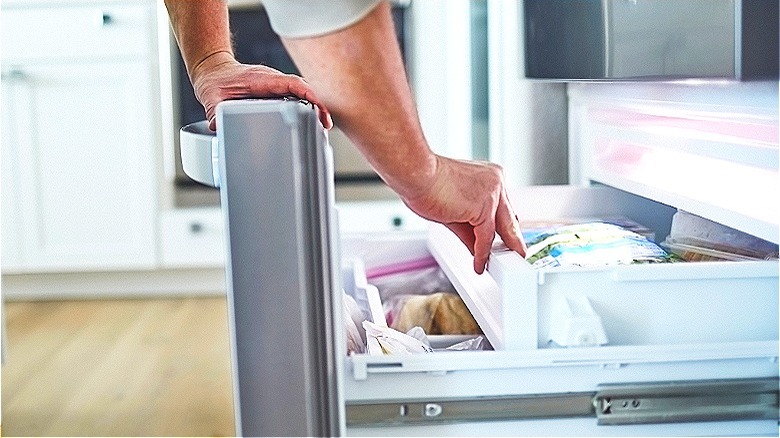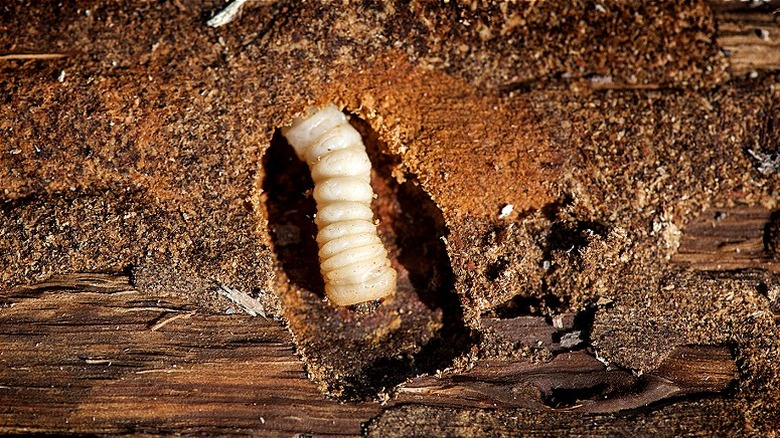The Hack That'll Help Protect New Small Antiques From Woodworm
Antique wooden pieces exude charm and character, making them cherished possessions for hobbyists, collectors, and homeowners alike. However, these timeless treasures aren't immune to the threat of woodworms, a type of wood-boring beetle larvae that can infiltrate and damage wooden items, including your newly bought small antiques. Fortunately, there's an easy hack you can try to get rid of woodworms: placing your antiques in the freezer.
Woodworms are drawn to antique wooden items for a few reasons. Firstly, antique wood often boasts ideal conditions for these pests: It's aged, well-seasoned, and can be slightly damp. This makes it easier for the worms to bore into the wood, creating tunnels as they feed. Secondly, wooden antique furniture and collectibles tend to be intricately designed, with numerous small cracks and crevices, providing the perfect hiding spots for the woodworm. If you suspect you have woodworms living in your antiques, you can try freezing the bugs out; all that's needed is for the antiques to be small enough to fit in a freezer.
How to eliminate woodworms in the freezer
Freezing small antique wooden items might seem like an unconventional method for pest control, but it can be effective in eradicating woodworms. Start by wrapping the infested antique piece in a thick plastic sheet or bag to protect it from moisture during the process. Place the wrapped antique in a deep freezer or chest freezer. As makers like Maytag note, a deep freezer can reach zero degrees Fahrenheit, or -18 C. You won't be able to set yours far below this, due to setting limits and also the fact that you'll need to think of the food in the freezer, too.
A freezer set at zero degrees, though, can kill woodworms. This said, according to the South West Museum Development, at this temperature, you'll need to keep the antique in the freezer for a few weeks. This extended exposure to freezing temperatures is necessary to ensure the larvae, pupae, and adult worms are all killed. When you remove the package, handle it with extreme care and then let it fully defrost before opening it to get to the antique.
Freezing works to eliminate woodworms by disrupting their biological processes. The cold temperatures cause ice crystals to form within their bodies, damaging their cells and tissues. One of the advantages of freezing is that it doesn't involve the use of harmful chemicals or toxins, making it a safe, eco-friendly option for pest control. It's particularly useful for small antique wooden items that may be too delicate for other treatment methods.
How to protect antiques from woodworms
Protecting cherished wooden antiques from woodworm infestations is essential to ensure their longevity and beauty. To safeguard your new valuable wooden pieces, routinely inspect your wooden antiques for any signs of woodworm activity. Look for small round exit holes, as well as fine powdery sawdust (or frass) and weakened wood. Catching an infestation early can make it easier to address.
Since woodworms thrive in damp conditions, ensure the humidity in your home remains low, especially in storage areas for wooden antiques. Using dehumidifiers and maintaining proper ventilation can help create an inhospitable environment for these pests. Before bringing a new antique wooden piece into your home, quarantine it for a few weeks to monitor it for any signs of woodworms. This precaution can prevent the spread of pests to your existing collection. If, however, you suspect your antique find is severely infested, consult a pest control expert to assess and treat the issue.


